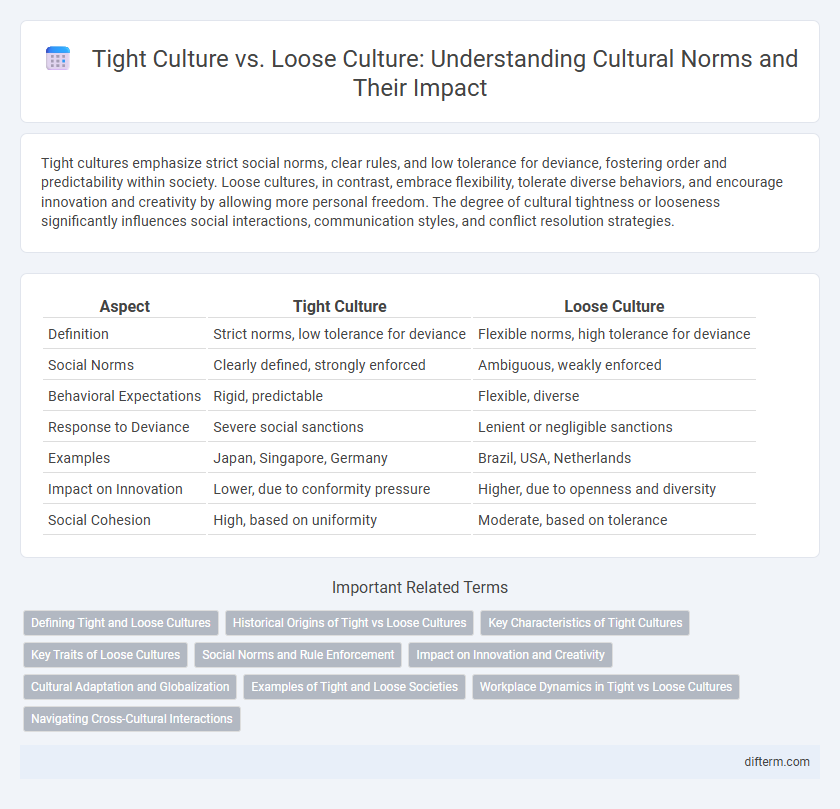Tight cultures emphasize strict social norms, clear rules, and low tolerance for deviance, fostering order and predictability within society. Loose cultures, in contrast, embrace flexibility, tolerate diverse behaviors, and encourage innovation and creativity by allowing more personal freedom. The degree of cultural tightness or looseness significantly influences social interactions, communication styles, and conflict resolution strategies.
Table of Comparison
| Aspect | Tight Culture | Loose Culture |
|---|---|---|
| Definition | Strict norms, low tolerance for deviance | Flexible norms, high tolerance for deviance |
| Social Norms | Clearly defined, strongly enforced | Ambiguous, weakly enforced |
| Behavioral Expectations | Rigid, predictable | Flexible, diverse |
| Response to Deviance | Severe social sanctions | Lenient or negligible sanctions |
| Examples | Japan, Singapore, Germany | Brazil, USA, Netherlands |
| Impact on Innovation | Lower, due to conformity pressure | Higher, due to openness and diversity |
| Social Cohesion | High, based on uniformity | Moderate, based on tolerance |
Defining Tight and Loose Cultures
Tight cultures enforce strict social norms and exhibit low tolerance for deviance, emphasizing order, discipline, and conformity, which is common in countries like Japan and South Korea. Loose cultures display flexible norms with higher tolerance for behavioral variation, promoting individual freedom and innovation, as seen in nations like the United States and Brazil. This classification largely depends on factors such as societal threats, population density, and historical experiences impacting cultural rigidity or permissiveness.
Historical Origins of Tight vs Loose Cultures
Tight cultures historically emerge in societies facing frequent ecological threats, population pressures, or warfare, fostering strict social norms and low tolerance for deviance to ensure survival and cohesion. Loose cultures often develop in environments with abundant resources and fewer external threats, promoting greater individual freedom and flexibility in social behaviors. Anthropological studies reveal that these cultural frameworks persist through generations shaped by historical challenges and collective adaptations.
Key Characteristics of Tight Cultures
Tight cultures are characterized by strict social norms, a low tolerance for deviant behavior, and strong enforcement of rules and traditions. These societies emphasize order, discipline, and conformity, often resulting in clear distinctions between acceptable and unacceptable conduct. High levels of social control in tight cultures foster predictability and stability within communities.
Key Traits of Loose Cultures
Loose cultures exhibit high tolerance for ambiguity and individuality, encouraging creativity and open expression while maintaining flexible social norms. They prioritize personal freedom and egalitarianism, resulting in diverse behavior patterns and less social conformity. Countries like the United States, Brazil, and Australia often demonstrate these loose cultural traits, fostering innovation and adaptability.
Social Norms and Rule Enforcement
Tight cultures maintain strict social norms with clear expectations for behavior, leading to rigorous rule enforcement and limited tolerance for deviance. In contrast, loose cultures exhibit more flexible social norms, allowing greater individual freedom and leniency in rule enforcement. This distinction affects social cohesion, conformity, and the collective response to norm violations within different societies.
Impact on Innovation and Creativity
Tight cultures with strict social norms and low tolerance for deviance tend to limit innovation and creativity by discouraging risk-taking and unconventional ideas. Loose cultures, characterized by relaxed social norms and high tolerance for diversity, foster environments where experimentation and novel thinking thrive. Research shows that organizations in loose cultures often achieve higher levels of innovative outcomes and creative problem-solving.
Cultural Adaptation and Globalization
Tight cultures, characterized by strong social norms and low tolerance for deviance, face greater challenges in cultural adaptation during globalization due to rigid behavioral expectations. Loose cultures, with more flexible norms and higher tolerance for variation, facilitate smoother integration and innovation in multicultural environments. Understanding these dynamics is essential for multinational organizations aiming to navigate global markets and foster effective cross-cultural collaboration.
Examples of Tight and Loose Societies
Japan exemplifies a tight culture with strict social norms, low tolerance for deviance, and strong emphasis on conformity and order. In contrast, Brazil represents a loose culture characterized by relaxed social rules, higher tolerance for deviant behavior, and greater acceptance of individual differences. The United States exhibits a mix of tight and loose cultural elements, varying regionally between communities with strong regulatory norms and others embracing more freedom and flexibility.
Workplace Dynamics in Tight vs Loose Cultures
Tight cultures emphasize strict workplace norms, clear hierarchies, and consistent rule enforcement, fostering predictability and conformity among employees. Loose cultures encourage flexibility, innovation, and open communication, resulting in adaptive and creative work environments. Understanding these cultural dimensions is crucial for multinational organizations to optimize team collaboration and employee engagement across diverse settings.
Navigating Cross-Cultural Interactions
Tight cultures emphasize strict social norms and clear rules, fostering predictability and order, while loose cultures encourage flexibility and tolerance for deviance, promoting creativity and adaptability. Understanding these cultural dimensions aids in navigating cross-cultural interactions by aligning communication styles, managing expectations, and reducing misunderstandings. Effective intercultural competence requires recognizing the tightness or looseness of a culture to tailor behavior, decision-making, and conflict resolution approaches accordingly.
tight culture vs loose culture Infographic

 difterm.com
difterm.com